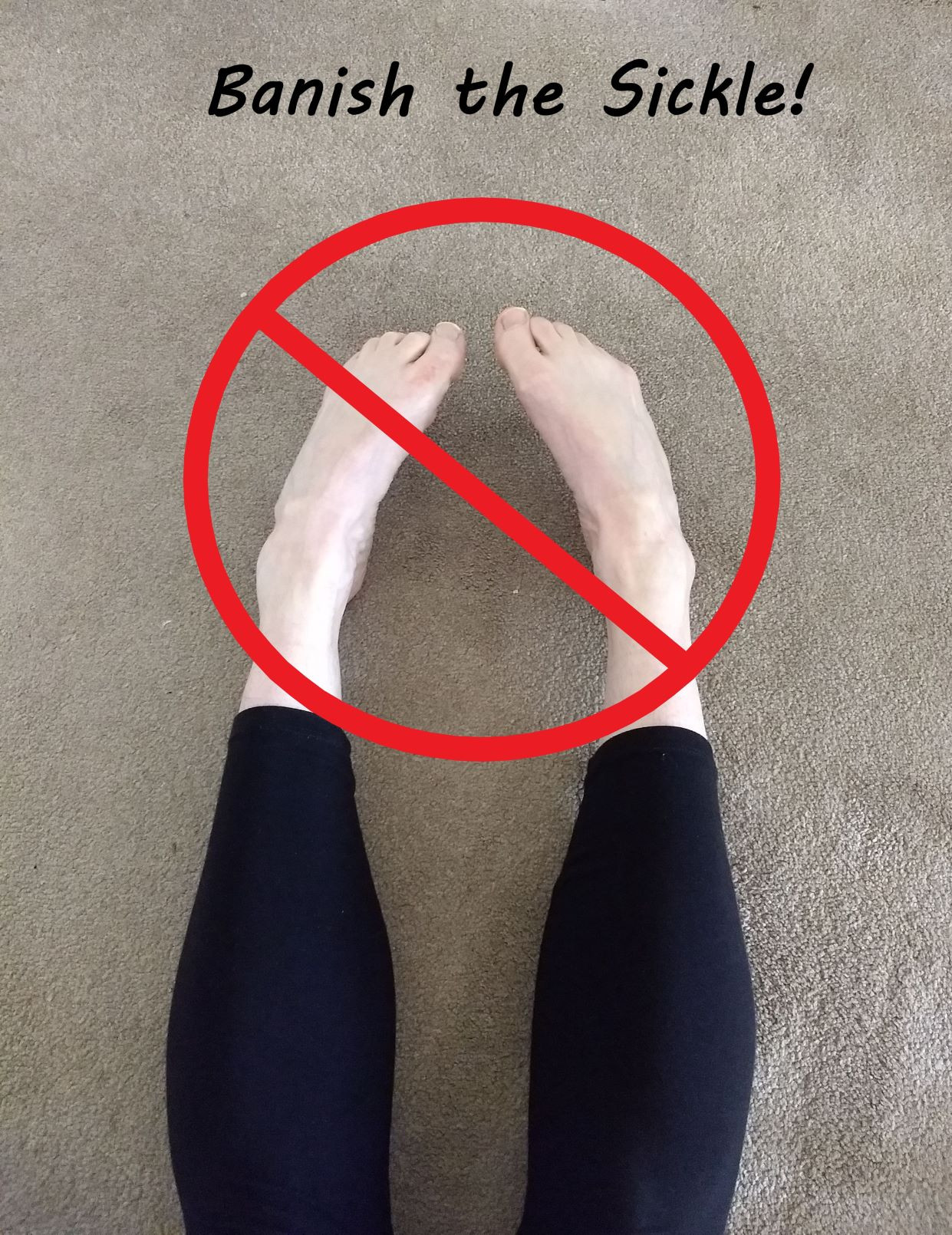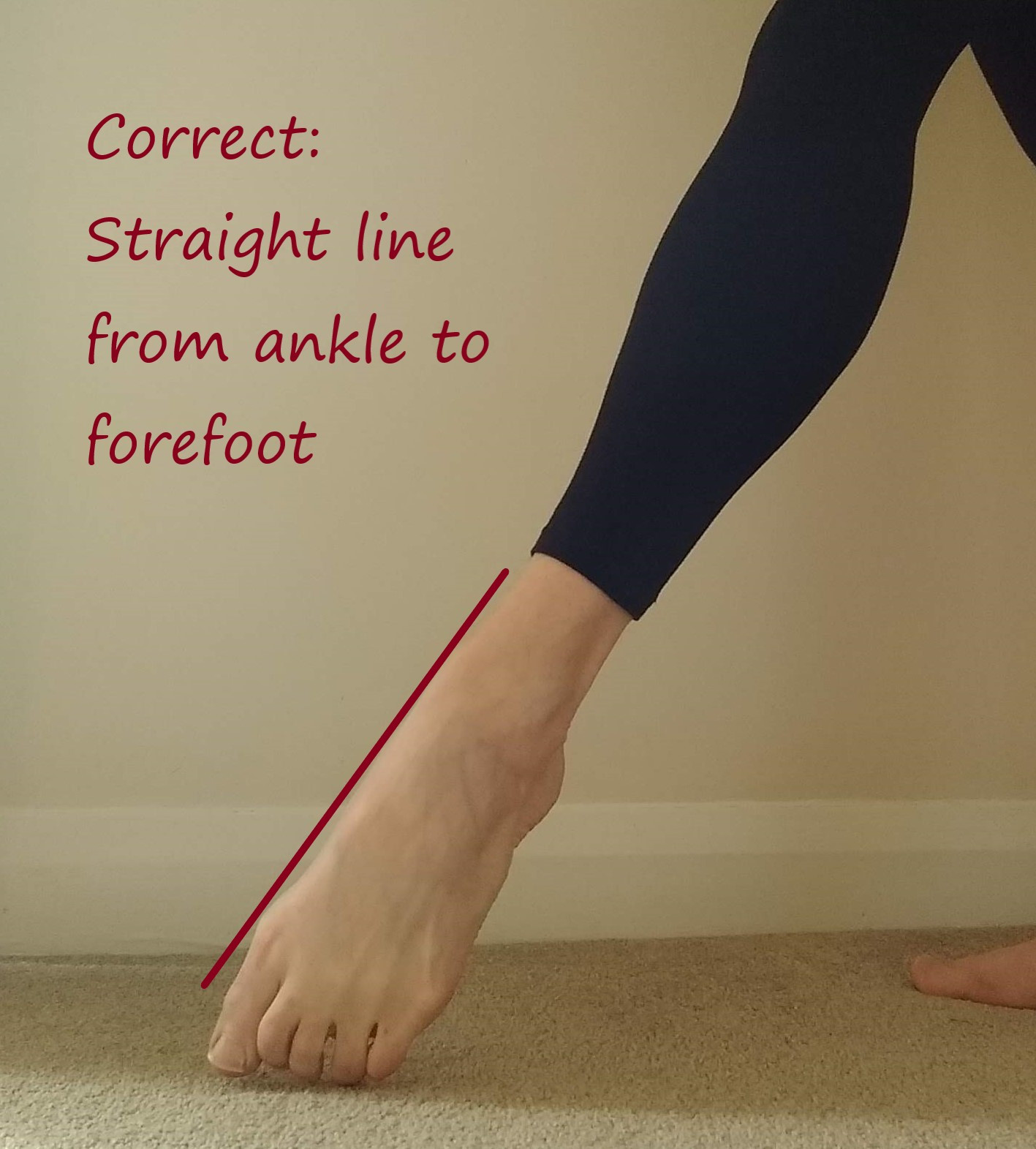Foot sickling is a prevalent issue among dance students, often arising when dancers push to extend their point range. This occurs when, in an attempt to point the foot further, the ankle rolls outwards, causing the foot to turn inwards. In dance, where aesthetics and lines are paramount, a sickled foot disrupts the desired visual harmony and, more importantly, poses significant risks.
From a physiotherapy and injury prevention perspective, sickling significantly elevates the risk of ankle injuries, particularly in demi-pointe and pointe work. The outward rotation of the ankle creates instability, making it susceptible to complete collapse and subsequent ankle sprains. It’s crucial for dancers to understand and correct this common misalignment to protect their ankles and maintain proper technique.
 Sickled foot in ballet
Sickled foot in ballet
Identifying Correct Foot Alignment
Determining correct alignment can vary slightly depending on individual foot shapes. However, the general principle involves achieving a straight line from the inside of the ankle to the forefoot. Ideally, the big toe should align with this line or be positioned slightly inwards. This neutral and strong position ensures proper force distribution and minimizes stress on the ankle joint.
 Correct foot alignment in tendu
Correct foot alignment in tendu
 Straight foot alignment in tendu
Straight foot alignment in tendu
Common Causes of Foot Sickling
Weakness in the foot and ankle musculature is the primary culprit behind foot sickling. Specifically, insufficient strength in the muscles located on the outer aspect of the ankle is often to blame. Dancers with limited foot and ankle flexibility are also more prone to sickling. This is because the foot and ankle naturally possess a greater range of motion when turned inwards, leading dancers to sickle in an attempt to artificially enhance their point range. Furthermore, inadequate motor control, or ingrained poor movement habits, can contribute to persistent sickling. Anatomical variations and individual foot and ankle structure can also play a role in a dancer’s susceptibility to sickling.
Effective Strategies to Correct Sickling
The cornerstone of correcting a sickled foot lies in strengthening the muscles of the foot and ankle. A targeted approach should prioritize building strength in the peroneal muscles, located on the outside of the ankle. These muscles are crucial for maintaining ankle stability and preventing the outward rolling motion characteristic of sickling.
Alongside strength training, developing refined motor control is essential. This involves cultivating good movement habits through consistent practice of correct alignment during exercises like pointing the foot and rising to demi-pointe. Regular practice ingrains the correct muscle activation patterns, allowing the proper foot position to become automatic and subconscious, reducing the likelihood of sickling.
Importantly, strengthening and improving motor control is the most effective and safe method for enhancing functional foot flexibility. This approach is preferable to potentially harmful methods like foot stretchers, which may force range of motion without addressing underlying strength and control.
Understanding the Winged Foot Position
The “winged foot” is a position often encouraged in dance, particularly for aesthetic lines in movements like arabesque. In a winged foot, the heel is pushed forward, with the forefoot and toes positioned behind the ankle line. While visually appealing in non-weight-bearing poses, adopting a winged foot in weight-bearing positions, similar to sickling, compromises ankle alignment and increases injury risk. If dancers wish to explore the winged foot position, it should be reserved for movements like arabesque or attitude, and only after achieving consistent straight foot alignment in fundamental movements. Mastering a correctly aligned, straight foot is paramount before attempting to incorporate winged foot variations.
Recommended Exercises for Foot and Ankle Strength and Control
Here are two highly effective exercises to enhance foot and ankle strength and improve motor control, crucial for correcting and preventing sickled feet:
- Single-Leg Demi-Plié and Relevé:
This foundational exercise effectively strengthens the feet, ankles, and calves while simultaneously improving motor control. Its functional nature mimics dance movements, making it highly relevant for dancers. Regular practice of single-leg demi-plié and relevé not only improves foot position but also serves as a powerful injury prevention tool, building strength and endurance to protect against a range of lower leg and foot injuries.
To perform this exercise, stand on one foot in parallel position. Slowly execute a demi-plié and relevé, focusing on maintaining correct foot and ankle alignment throughout the movement. Using a mirror or seeking feedback from a teacher or peer can help ensure proper form. Begin with 10 repetitions on each foot and gradually progress to 3 sets of 20 repetitions.
- Point and Flex with Theraband Loop (Modified):
While traditional theraband point and flex exercises are common, a modified approach is more effective in targeting the peroneal muscles and preventing sickling. The standard theraband exercise can often be performed incorrectly, inadvertently reinforcing sickling or promoting toe clawing, which creates undesirable tension and poor habits.
For this variation, sit with legs extended straight in front of you in parallel. Secure a theraband around your forefeet, ensuring sufficient tension to create resistance on the outside of your ankle when the foot is in a neutral position. Slowly perform point and flex movements, maintaining correct foot alignment throughout the exercise. This variation effectively engages the peroneal muscles, promoting ankle stability and preventing sickling while building overall foot strength and control, which are essential for safely increasing functional pointe range.
For dancers seeking to further advance their foot and ankle strength and control, exploring more advanced exercises, such as eccentric heel drops and exercises detailed in resources like “Banish the Sickle, Part 2” video, can be beneficial.
By understanding the mechanics of foot sickling, its causes, and implementing targeted exercises, dancers can effectively correct this misalignment, enhance their technique, and minimize their risk of ankle injuries, ensuring a healthier and more sustainable dance journey.
